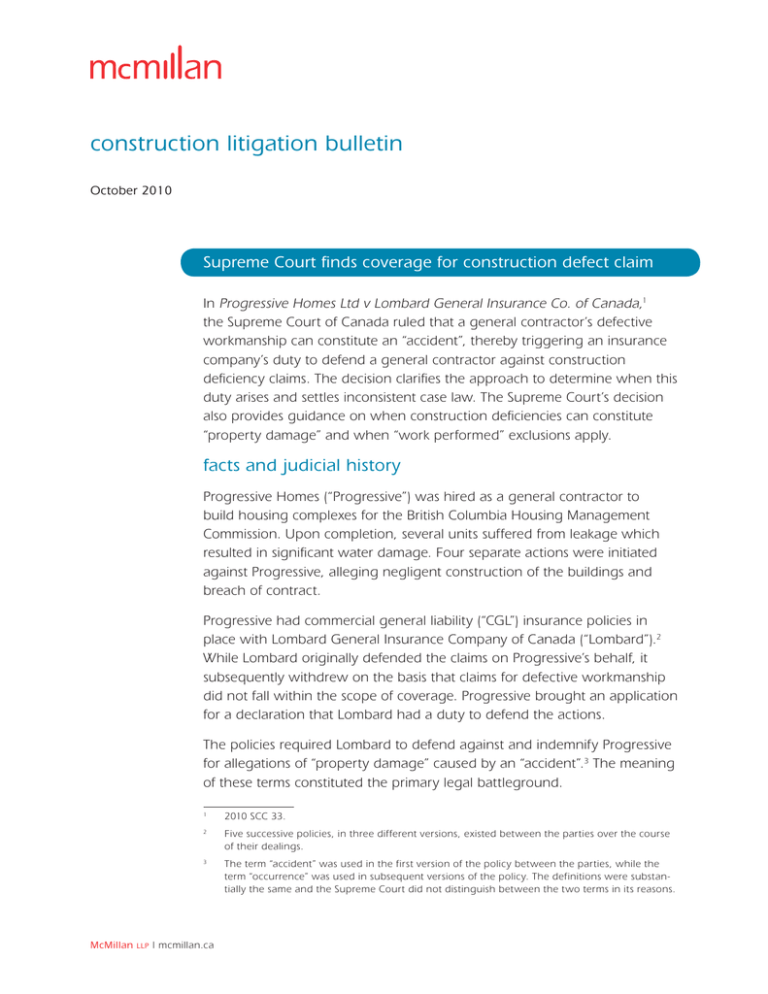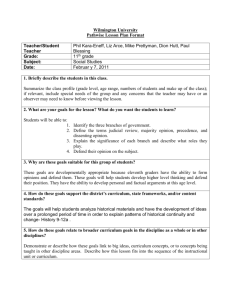Supreme Court finds coverage for construction defect claim
advertisement

construction litigation bulletin October 2010 Supreme Court finds coverage for construction defect claim In Progressive Homes Ltd v Lombard General Insurance Co. of Canada,1 the Supreme Court of Canada ruled that a general contractor’s defective workmanship can constitute an “accident”, thereby triggering an insurance company’s duty to defend a general contractor against construction deficiency claims. The decision clarifies the approach to determine when this duty arises and settles inconsistent case law. The Supreme Court’s decision also provides guidance on when construction deficiencies can constitute “property damage” and when “work performed” exclusions apply. facts and judicial history Progressive Homes (“Progressive”) was hired as a general contractor to build housing complexes for the British Columbia Housing Management Commission. Upon completion, several units suffered from leakage which resulted in significant water damage. Four separate actions were initiated against Progressive, alleging negligent construction of the buildings and breach of contract. Progressive had commercial general liability (“CGL”) insurance policies in place with Lombard General Insurance Company of Canada (“Lombard”).2 While Lombard originally defended the claims on Progressive’s behalf, it subsequently withdrew on the basis that claims for defective workmanship did not fall within the scope of coverage. Progressive brought an application for a declaration that Lombard had a duty to defend the actions. The policies required Lombard to defend against and indemnify Progressive for allegations of “property damage” caused by an “accident”.3 The meaning of these terms constituted the primary legal battleground. McMillan LLP 1 2010 SCC 33. 2 Five successive policies, in three different versions, existed between the parties over the course of their dealings. 3 The term “accident” was used in the first version of the policy between the parties, while the term “occurrence” was used in subsequent versions of the policy. The definitions were substantially the same and the Supreme Court did not distinguish between the two terms in its reasons. | mcmillan.ca construction litigation bulletin The trial judge denied the application and held that Lombard did not have a duty to defend the claims. A majority of the Court of Appeal for British Columbia agreed, ruling that defective workmanship could not be considered an accident and, as such, could not fall within the coverage. According to the Court, allowing coverage for faulty workmanship would fly in the face of the “underlying assumption that insurance is designed to provide for fortuitous contingent risk.” Progressive appealed the decision. the Supreme Court’s conclusion The Supreme Court was unanimous in its ruling that Lombard owed a duty to defend the general contractor. The Court reaffirmed the well-established principle that the duty to defend arises when facts alleged in pleadings, if proven true, would require the insurer to indemnify the insured pursuant to the policy. It is irrelevant whether allegations can be proven in evidence. The duty to defend is much broader than the requirement to actually indemnify. The mere possibility that a claim falls within coverage will trigger the duty to defend. The Court also emphasized the importance of relying on the plain language of the policy to determine its meaning. When the language of a policy is clear, the court should give effect to that language, reading the contract as a whole. Where the language of the policy is ambiguous and the general rules of contract construction fail to resolve the ambiguity, the court will interpret coverage provisions broadly and exclusionary clauses narrowly. The decision sets out an analytical framework to determine whether a claim falls within the ambit of coverage. A CGL policy will typically provide for the following: a. the type of coverage; b. exclusions, which preclude coverage when the claim would otherwise fall within the policy; and c. exceptions to the exclusions, which bring an otherwise excluded item back within coverage. The Court held that it is appropriate to interpret insurance policies in this order. If a claim falls within the initial scope of coverage, and coverage is not precluded by an exclusionary clause, there will be a duty to defend. McMillan LLP | mcmillan.ca 2 construction litigation bulletin “property damage” caused by an “accident” Lombard argued that the definition of property damage did not include damage to the insured’s own building caused by another part of that same building, and as such, the claims were not covered. This argument was in accordance with the Supreme Court’s previous rejection of the complex structure theory in tort law.4 However, the Supreme Court rejected Lombard’s argument by focusing on the plain language of the policy at issue. The definition of property damage found in the policies was not limited to damage to third party property, as Lombard had argued. The Court held that the definition found in the policies was broad enough to include damage to any tangible property, whether third party property or the property constructed by the insured. Relying on the proposition that insurance should only protect against fortuitous risk, Lombard also argued that when a building is constructed in a defective manner, the end result is a defective building, never an accident. The Court rejected this approach. Instead, the Court found that the classification of defective workmanship as an accident is a case-specific determination. Faulty construction of a building can amount to an accident covered under the CGL policy. In the policies at issue, the term accident was defined broadly enough to include defective workmanship. Given these interpretations, the Court was satisfied that the pleadings sufficiently fell within the initial scope of coverage. “work performed” exclusion and “subcontractor” exception Lombard could avoid the duty to defend if coverage for the claims was precluded through an exclusionary provision in the policy. Lombard relied upon a “work performed” exclusion, which precluded coverage for damage sustained to the insured contractor’s own work once completed. This common exclusion is sometimes accompanied by a subcontractor exception, which operates to bring the damage caused by or to a subcontractor’s work back within the scope of coverage. The Supreme Court ruled that Lombard had not demonstrated that the “work performed” exclusion clearly excluded the claims contained in the pleadings. In the first version of the policy between the parties, a subcontractor exception brought the damage caused by or to a subcontractor’s work back within coverage. The Court then parsed the language of the second version of the policy and held that it only excluded coverage for repairing defective components of the building, but did not exclude coverage for the damage resulting from those defective components. The final version of the policy was an amalgamation of the first two, containing a subcontractor exception as well as providing coverage for damage resulting from 4 McMillan LLP Winnipeg Condominium Corporation No. 36 v. Bird Construction Co. [1995] 1 SCR 85. | mcmillan.ca 3 construction litigation bulletin defective components. In each version of the policy, the Court found that the duty to defend existed. The decision is restricted to the duty to defend – the determination of what damages are covered or excluded under the policy was to be determined at trial. implications The Supreme Court’s decision highlights the importance of providing clear and comprehensive definitions of critical terms within insurance policies. Insurers with similar CGL policies may be more inclined to participate in litigation from the outset where previously they would have simply denied coverage. They may also be compelled to review their policies to identify ambiguities and ensure that coverage and exclusions are expressed clearly. General principles of law, even those wellestablished in tort, are no substitute for the language of the contract. Both insurers and those insured would be well advised to carefully review their policies to confirm that the language used achieves their objectives. by Lindsay Lorimer, Jason J. Annibale and Richard McCluskey For more information on this topic, please contact: Toronto Toronto Toronto Lindsay Lorimer Jason J. Annibale Richard McCluskey 416.865.7197 416.865.7912 416.865.7146 lindsay.lorimer@mcmillan.ca jason.annibale@mcmillan.ca richard.mccluskey@mcmillan.ca For further information or advice in relation to our Construction Litigation practice, please contact: Calgary Toronto Montréal Michael A. Thackray, QC 403.531.4710 Luigi (Lou) Macchione 416.865.7116 Earl Cohen 514.987.5045 michael.thackray@mcmillan.ca luigi.macchione@mcmillan.ca earl.cohen@mcmillan.ca a cautionary note The foregoing provides only an overview and does not constitute legal advice. Readers are cautioned against making any decisions based on this material alone. Rather, specific legal advice should be obtained. © McMillan LLP 2010 McMillan LLP | Lawyers | Calgary | Toronto | Montréal | mcmillan.ca


